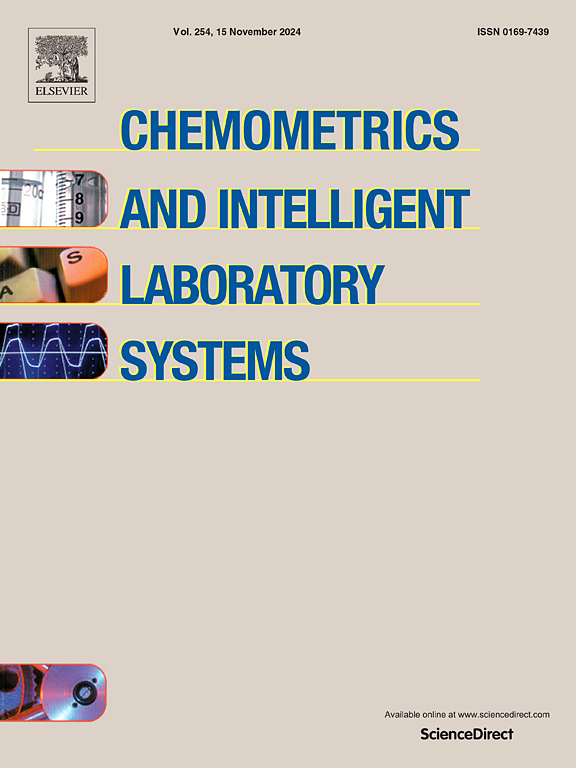A novel three-dimensional strategy to elucidate the interactions of two fluoroquinolones with DNA using two-dimensional fluorescence maps
IF 3.8
2区 化学
Q2 AUTOMATION & CONTROL SYSTEMS
Chemometrics and Intelligent Laboratory Systems
Pub Date : 2025-05-14
DOI:10.1016/j.chemolab.2025.105437
引用次数: 0
Abstract
A novel three-dimensional strategy was introduced to elucidate the interactions of two fluoroquinolones, ciprofloxacin (CIP) and norfloxacin (NOR), with DNA using two-dimensional fluorescence maps (fluorescence excitation and emission measurements). This chemometric strategy is based on decomposing fluorescence excitation-emission matrices to extract detailed excitation, emission, and concentration profiles. By recording the fluorescence spectra after the reactions of CIP and NOR with calf thymus DNA and applying parallel factor analysis (PARAFAC) to the resulting data array, the quantitative estimations of the excitation and emission curves and the relative concentrations of the drugs and their DNA complexes were achieved. This investigation revealed the intricate interactions between CIP and DNA and NOR and DNA, characterized by Stern-Volmer constants (Ksv) and quenching rate constants (Kq). These constants related to the drug-DNA reaction equilibrium were derived from the correlation between actual DNA concentrations and the estimated relative amounts of CIP and NOR. The binding constants obtained through our innovative three-dimensional strategy were rigorously compared with those determined by classic spectrophotometric and spectrofluorometric methods, highlighting the efficacy and accuracy of our proposed approach.
一种新的三维策略来阐明两种氟喹诺酮类药物与DNA的相互作用,使用二维荧光图
利用二维荧光图谱(荧光激发和发射测量),研究了环丙沙星(CIP)和诺氟沙星(NOR)两种氟喹诺酮类药物与DNA的相互作用。这种化学计量策略是基于分解荧光激发-发射矩阵,以提取详细的激发,发射和浓度分布。通过记录CIP和NOR与小牛胸腺DNA反应后的荧光光谱,并对所得数据阵列进行平行因子分析(PARAFAC),实现了药物及其DNA复合物的激发和发射曲线以及相对浓度的定量估计。该研究揭示了CIP与DNA、NOR与DNA之间复杂的相互作用,其特征为Stern-Volmer常数(Ksv)和猝灭速率常数(Kq)。这些与药物-DNA反应平衡有关的常数是由实际DNA浓度与估计的CIP和NOR的相对量之间的相关性得出的。通过我们创新的三维策略得到的结合常数与经典的分光光度法和荧光光谱法测定的结合常数进行了严格的比较,突出了我们提出的方法的有效性和准确性。
本文章由计算机程序翻译,如有差异,请以英文原文为准。
求助全文
约1分钟内获得全文
求助全文
来源期刊
CiteScore
7.50
自引率
7.70%
发文量
169
审稿时长
3.4 months
期刊介绍:
Chemometrics and Intelligent Laboratory Systems publishes original research papers, short communications, reviews, tutorials and Original Software Publications reporting on development of novel statistical, mathematical, or computer techniques in Chemistry and related disciplines.
Chemometrics is the chemical discipline that uses mathematical and statistical methods to design or select optimal procedures and experiments, and to provide maximum chemical information by analysing chemical data.
The journal deals with the following topics:
1) Development of new statistical, mathematical and chemometrical methods for Chemistry and related fields (Environmental Chemistry, Biochemistry, Toxicology, System Biology, -Omics, etc.)
2) Novel applications of chemometrics to all branches of Chemistry and related fields (typical domains of interest are: process data analysis, experimental design, data mining, signal processing, supervised modelling, decision making, robust statistics, mixture analysis, multivariate calibration etc.) Routine applications of established chemometrical techniques will not be considered.
3) Development of new software that provides novel tools or truly advances the use of chemometrical methods.
4) Well characterized data sets to test performance for the new methods and software.
The journal complies with International Committee of Medical Journal Editors'' Uniform requirements for manuscripts.

 求助内容:
求助内容: 应助结果提醒方式:
应助结果提醒方式:


